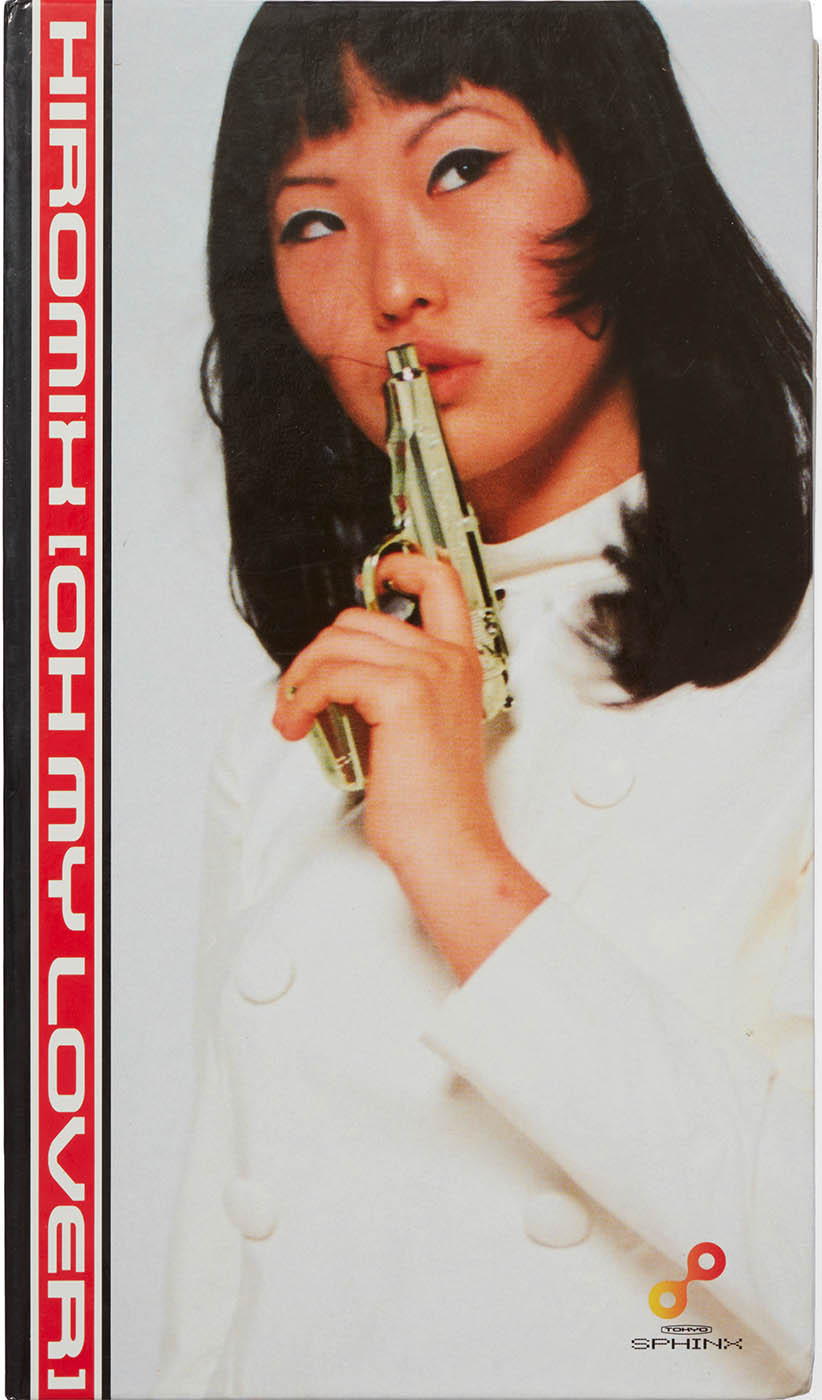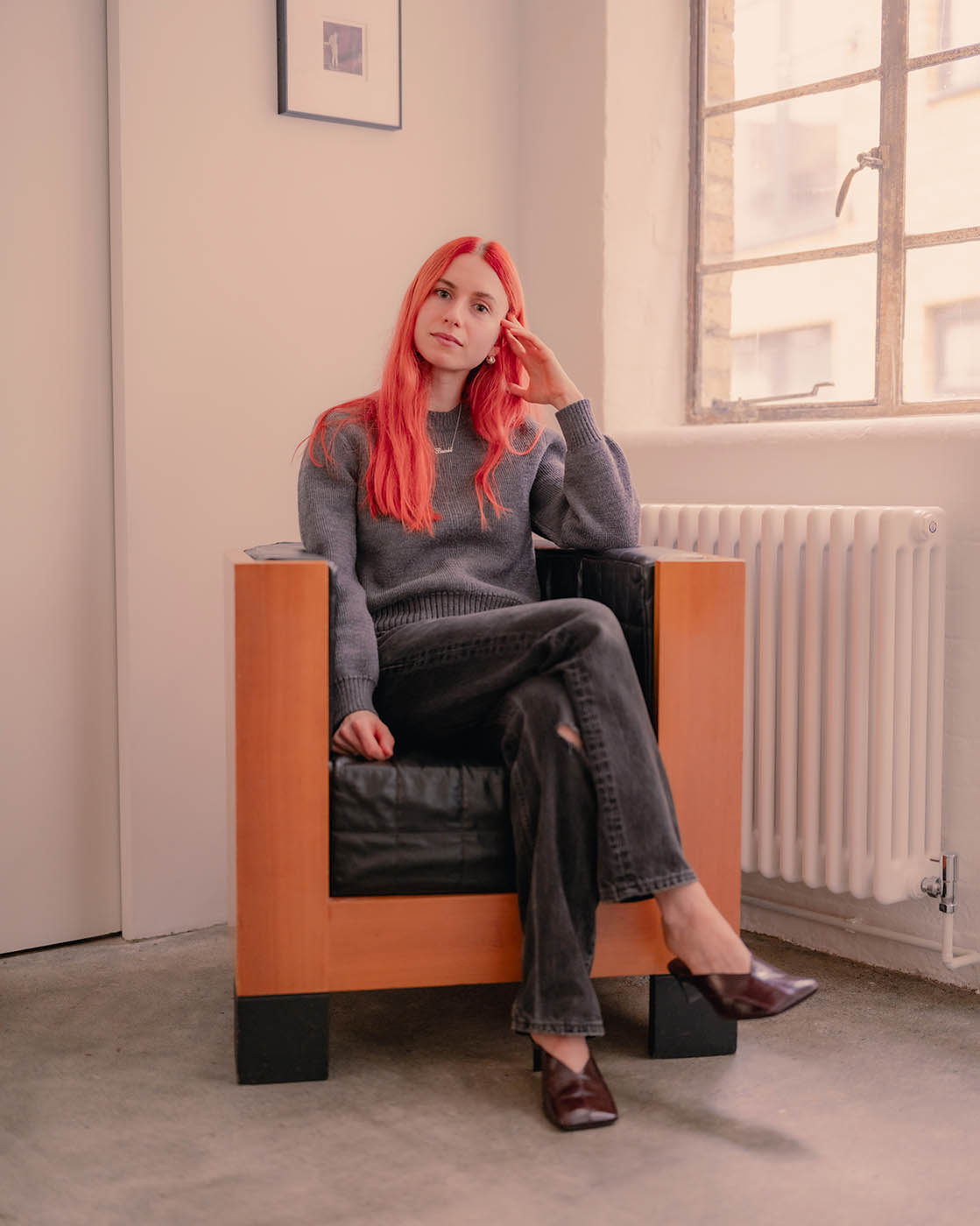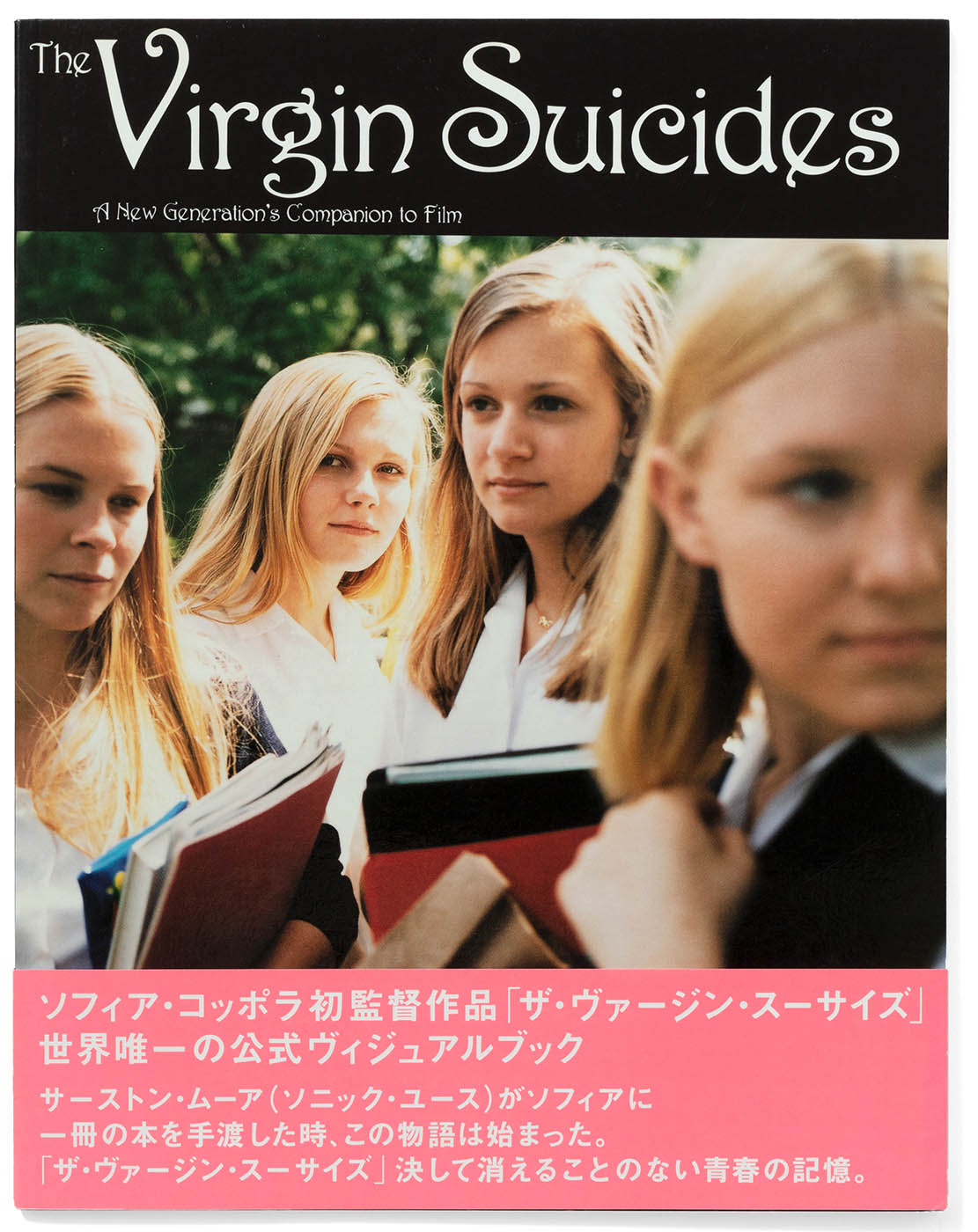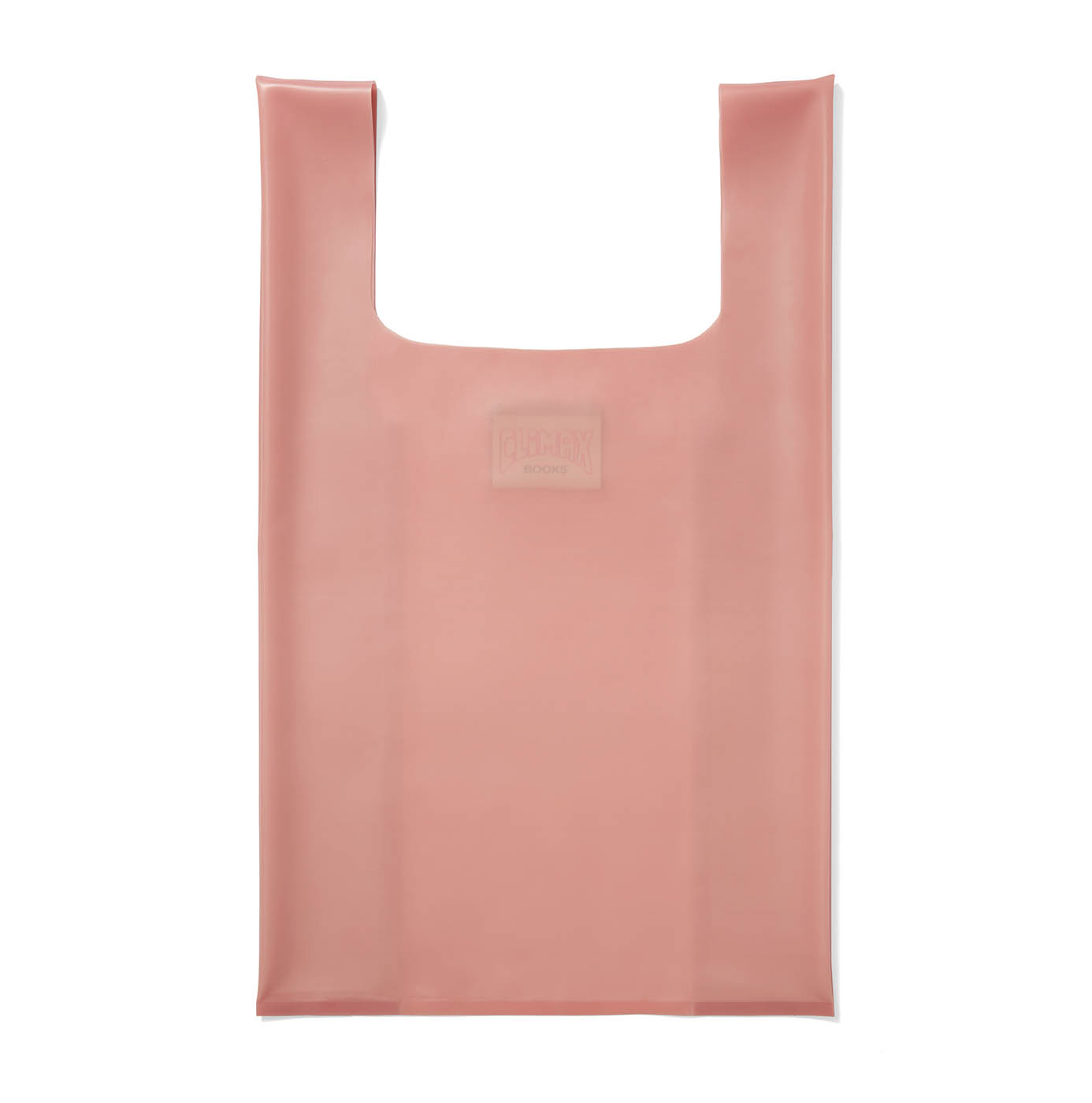Photographs Cian Oba-Smith
Inside Isabella Burley’s white mews home in Clerkenwell, London, there is a stainless-steel kitchen, three sleek pieces of furniture, a velvety whippet named Bambi, and that’s it. The lack of stuff (a single silver kettle sits on a kitchen surface, one yellow orchid on the table) would be less surprising were she not the founder of one of the most interesting new bookshops in the world.
Established in London in 2020, initially online, Climax sells rare or overlooked books and erotica, alongside branded (what Burley calls) “wearables” – cropped pink hoodies, socks, a latex shopping bag. Currently for sale are an invitation to a Robert Mapplethorpe exhibition from 1979 and the first edition of a book called A Project with Björk along with posters, books and ephemera from a recent history of cult art. A first pressing of Madonna’s Sex book, a Japanese VHS of John Waters’ infamous Pink Flamingos and a Virgin Suicides zine have all sold out.
To enter the New York store with its pink tinted windows, which opened last year, or the London shop that opens near her home next month, is to step quite quickly into Burley’s mind, a place of provocative, disarming creativity. She grew up in south London, dipping in and out of art college and working at American Apparel, where shop girls appeared in the company’s controversial adverts wearing hotpants and tube socks. In 2007, aged 17, she got a job at Dover Street Market, the Mayfair concept store created by Comme des Garçons’ Rei Kawakubo and her husband Adrian Joffe. This was a place of “beautiful chaos,” Joffe said recently, where the cashier sat in a little wooden hut amid teetering art installations. On the shop floor Burley would wear a long Junya Watanabe ballgown with an open back and (purchased with her first paycheck) platform shoes with leather fringes that swished perilously across the concrete floor.

Sophisticated tastes: much of the Climax Books stock came from specialist Japanese suppliers
“Dover Street was my education,” she says. “Really iconic creative people like [graphic designer] Peter Saville or [fashion designers] Rick Owens and Michele Lamy came in. And because I was so young, people took me under their wing in a really sweet and very generous way. There was a constant creative conversation happening.” When Dover Street Market opened, in 2004, it felt like the centre of avant-garde fashion. As well as passersby who came in off the street, appalled and confused by the store, “there were the really hardcore Comme des Garçons fans, who would leave in crazy 2D-printed sculptural pieces they’d just bought. It was amazing to see these museum pieces worn out in real life.” Still living with her German mother and New Zealand-born father (in a house she describes, with affection, as “quite hoarder-ey”), she left art school early, frustrated at the obligation to listen to lectures about people she’d interviewed yesterday while freelancing for British style magazine Dazed. Her time at art school was largely spent photocopying books in the library, then pasting them together. Later, she realised she was editing magazines.
Burley worked for a year as the fashion features editor of Dazed, then another as editor and then, at 24, she became their youngest ever editor-in-chief. For the first time they had somebody reflecting youth culture from the inside. The magazine landscape was shifting as print media adapted to online platforms. In the fashion press, music journalists were being replaced by stylists. Giving Burley the job of editor-in-chief, says Jefferson Hack, Dazed’s CEO and co-founder, “was a natural progression, one she truly earned, having found her voice early in her creative journey. She was always so plugged-in to the coolest scenes in London. Age and experience never factored into it, she was just ready for that next step. It made perfect sense that the person behind the magazine reflected the energy and spirit of the person reading it.”
A memorable Dazed cover, their 25th anniversary issue in 2016, involved Burley interviewing Pamela Anderson, reframing her as a “postmodern artist” – the shoot by Zoë Ghertner had Anderson on a beach in Yeezy and Simone Rocha, and Burley’s piece began with a quote about Anderson from Ed Ruscha. After a year spent commuting between London and New York as editor-in-residence for Helmut Lang, she became the brand’s creative editor, then chief marketing officer at the luxury Swedish label Acne Studios.

Isabella Burley: working at Oxfam she learned ‘how important books are for different types of people’
In lockdown, Burley launched Climax as a rare book dealership online from her bedroom and, this year, having just turned 35, she’s expanding, opening a new, grand brick-and-mortar store – previously its London branch was hidden down a tiny Soho sidestreet. It was there that she launched its first publication, a book of photos taken in the 1990s by Sophy Rickett, called Pissing Women. All the pieces of her life to date, “have clashed together in this strange way, challenging the traditional notions of a bookstore.” If it’s intriguing, her thinking is, “you’re going to consume it”.
While the store carries “uncompromising voices that we love, like Kathy Acker or Gary Indiana, or Hilton Als or Bell Hooks,” Climax’s social media sees celebrity customers like Kyle McLachlan and Dev Hynes talking about the books that have influenced their lives, alongside “educational” series about art and film – as the market for print dissolves, this, perhaps, is what a magazine might become. “The wearable product side of what we do is such a huge part of it now, too, and it’s really fun to be like, ‘Could Climax be a pair of reading glasses?’ It feels so limitless.” One of its bestselling products is the latex shopper, a nod to traditional bookshops’ canvas tote bags, but made by a gay sexwear company in the UK. They are transparent and stiff, with a slight wobble. A balance of luxurious and thoughtful, “with a tongue-in-cheek winkiness”.
Behind a white cupboard door off Burley’s kitchen are the only books in the house. Here is a shelf of monographs and vintage pornography, including a 1980s fetish magazine called Madame in a World of Fantasy. The back cover is a black and white image of a woman with a whip, framed with a graphic illustration of an opening zip. The books and ephemera that Burley collects are typically shared with, then dissected by, designers who will use this inspiration to shape a collection or aesthetic that will inevitably trickle down through the culture, emerging in various forms on the high street two years from now. This is how fashion has always worked, artful magpies picking through history and reshaping what they find for now. The word “influencer” has hardened and sharpened as social media became a viable career path. Burley is like an influencer from a different time – there is a quiet coolness here that comes with experience. She’s not telling you, necessarily, what to buy, but instead what to read, or how to look at an image, meticulously and with purpose. She wears no makeup, a square-toed mule and the word Bambi in silver round her neck. Though she was a club kid in her teens, zipping from the shop floor to a club, then getting a night bus home before school, a journalist who knew her said by the time she was at Dazed there was no hedonism evident, that Burley took the work very seriously and approached fashion through a literary lens. Another told me she was “scary, in a good way”.

Gone already: the Virgin Suicides zine is sold out
She pulls out another Japanese fetish magazine, which features another woman with a whip, this time in saturated colour, and describes the picture, while holding it delicately, as if a bible. “She’s wearing an oversized men’s shirt in this acid yellowy green and matching socks with a whip in hand. It’s so iconic on every level. Sometimes we’ll see a page like this and be, ‘Oh, let’s make a hoodie in this colour palette.’” These are publications designed for men’s pleasure, deconstructed and appreciated decades later by a woman for its bold visual language and loaded sense of luxury. And because it would be fun as a hoodie.
Stacked beside the fetish fanzines is a slim pamphlet from 2006 by German artist Wolfgang Tillmans called Why We Must Provide HIV Treatment Information, and a glossy catalogue of portraits by the art photographer Nigel Shafran, produced to market a block of John Pawson-designed apartments. While much of the Climax stock comes from Burley scouring eBay, or from specialised Japanese stores, she found this while volunteering at an Oxfam bookshop, in a brief gap between major fashion jobs.
It was here, too, that she first came across Sophy Rickett’s women. Working at Oxfam (she says, flicking through pages of leather fetishwear), she learned, “the value of things. And about community, and how important books are for different types of people.” Burley is noticing a shift in the interest of customers (around 60% of whom are women), from the 90s to the 2000s. She’s keen to continue joining dots for them in the same way her fellow shop girls did for her when she was 17 – the bookshop as a project in cultural education. Browsers are welcome – each store has a little reading area, upholstered in latex.
Being a shop girl completely shaped my life, my aesthetics, everything. I learned so much…
Despite her many and varied careers, a huge part of Burley’s identity remains fixed, she says, as “shop girl”. It’s a frilly yet loaded phrase that describes a role that’s sometimes theatrical and where power (status, money, knowledge) regularly flips. You’re decorative, yet in charge; subservient yet able to guide a customer towards something they want that you want them to buy. “Being a shop girl completely shaped my life, my aesthetics, everything. I learned so much. And when we opened New York, a lot of friends were like, ‘Oh my God, I want to play shop girl, too!’”
Friends who had worked in retail and now were successful stylists or art directors, or artists, “People like [content creator and former porn actor] Mia Khalifa, who has been a customer for a while.” Khalifa worked a shift wearing one of their Book Fantasy shirts, posing coyly behind the stainless-steel desk. Supermodel Paloma Elsesser, a Climax regular, explains its appeal. “It feels like stepping into Isabella’s brain: it’s tender, subversive, funny and full of feeling.” It’s a place Elsesser goes, “to be surprised, or to remember that desire and curiosity can be deeply personal. I’ve spent hours there, pulling things at random, talking shit with friends. Isabella has created somewhere that reminds you that taste can be intimate, even a little mischievous, and I love that.” Recently, Climax started selling a cropped T-shirt that says, ‘I only go to Climax for the shop girls’.

Bestseller: the latex shopper, a nod to traditional bookshops’ canvas tote bags, but made by a gay sexwear company
There is the question now, as Climax makes its way across the world (with sites planned for Los Angeles, then hopefully Paris and Seoul), with Burley as its face, of how she feels about shop girl evolving to “It girl”. Burley, who speaks with singsong earnestness, and is planning to switch her ketchup-red hair for blonde, contemplates as Bambi watches politely. “I think It girl was often used for people who weren’t doing things, but I’m happy to be an It girl when it’s about the work that I put out, because that’s really meaningful to me.” She’s ambitious for the brand. As well as the new stores (in New York people dawdle outside, unsure of whether it’s a gallery, or sex shop, or both) she’s thinking seriously about the fashion – the shirts, the reading glasses. “I feel like we can be the next Supreme,” she says, unblinking. “I don’t see why not.”
For all her pivots, from shop girl to editor to couture librarian, fashion remains her obsession. “I don’t think there’s a distinction any more between a magazine or a brand or a bookstore – it’s just information.” Fashion, as a part of that, “can be outrageous and a bit unnecessary, but also totally necessary”. While a woollen coat might keep the wind off your back, it can also have wings. “And all the weird contradictions that exist in fashion, for me, totally exist in Climax.” What she’s saying is, the most interesting new bookshop in the world is not just a bookshop. It’s a rare invitation into Burley’s world. A siren sounds outside and the dog purrs. “Climax is an attitude.”

